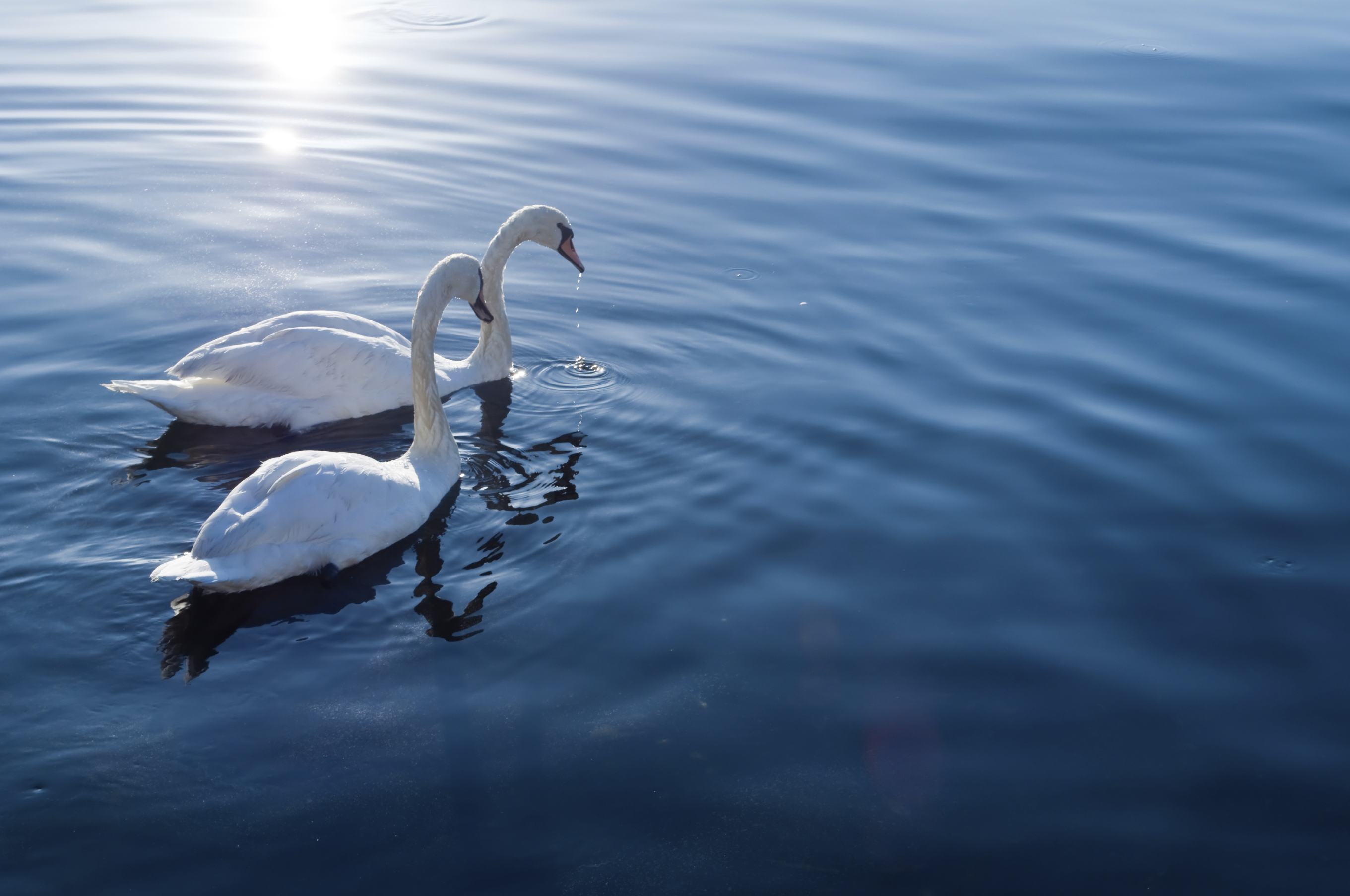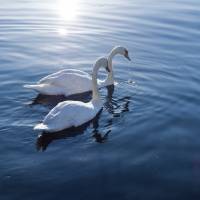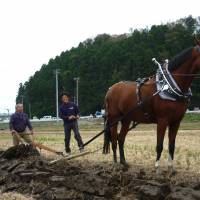Soon after the Great East Japan Earthquake of March 11, 2011, and the huge tsunami it triggered that killed almost 16,000 people and left more than 2,500 missing in the Tohoku region of northeastern Honshu, our C.W. Nicol Afan Woodland Trust contacted the many towns affected and invited survivors to spend a few days with us in the northern Nagano Prefecture hills.
We did so because we are very confident — based on a decade's experience of bringing children traumatized by abuse or neglect, and ones who are visually challenged, to spend a few days in our woods — that those vibrant, living surroundings are places of healing.
Consequently, 27 adults and children from Higashi-Matsushima, a small city on the coast of Miyagi Prefecture, became the first group to stay when they spent three days with us in August 2011.
An unexpected result of their visit was that the townspeople asked us to help them with the construction of a new elementary school on a densely wooded hill. At last the foundations have been laid, and the school should be finished by Christmas Day — Dec. 25, 2016.
When I first visited Higashi-Matsushima in November 2011, the extent of the devastation really hit me. Yet one time, when a V-formation wedge of whooper swans flew overhead as I was standing by the ruins of a high school on the coast, they were such a magnificent sight that I felt a surge of hope and joy. I was immediately convinced that nature would heal, and our job would be to do whatever we could to help, and try to understand that process.
Whooper swans (Cygnus cygnus) that overwinter in Japan migrate in spring to northern Honshu, then on to eastern Hokkaido before flying via Sakhalin Island to their breeding grounds in Siberia.
They are big birds with a wingspan of 205-275 centimeters. Adult males weigh 10-11 kilograms, while females are just a couple of kilos less. Despite their size, they are magnificent fliers, and when they pass overhead you can clearly hear the whistle and rush of the wind in their pinions.
Swans are lovely white birds that are the subject of many legends, stories, poems and songs — not forgetting ballet, of course. They mate for life, with the male very protective of his mate and the nest — and both extremely territorial. They are real family birds, cygnets stay with their parents through their first winter — and others from previous years sometimes join them.
Back when I was a little boy in Britain, I probably thought a swan's main diet was bread, because that's what people used to feed the tame ones on rivers and lakes and ponds in parks. Actually bread is not good for them, and in nature they feed on aquatic vegetation and algae, small mollusks, fish, tadpoles, frogs and worms. They also feed on land, especially on grain fields after the harvest.
In Higashi-Matsushima, one of our great supporters is Toshiro Abe, president of Nobico agricultural production company that is located there. As leader of the local volunteer fire brigade, he is one of the many unsung heroes who struggled in the most awful cold, wet and often dark conditions to rescue the living and recover the dead when catastrophe struck. He is a friendly, genial man, but he's no pushover and can be very stubborn and persuasive.
Immediately following the disaster, when his fields were strewn with debris after being flooded with seawater, Abe began working to bring the land back into production despite government officials telling him it wasn't feasible to do that so quickly. The very next year, his paddies produced excellent, high-quality rice and, over the past few years, he and his staff have worked to not only improve the quality of the rice, wheat and soybeans they grow, but also to make products such as cakes, biscuits, bread and nattō (fermented soybeans — lovely stuff) to sell directly to customers.
Abe has always actively supported our children's programs, and after I convinced him that a wooden school lessened the occurrence of allergies, colds and influenza in children — and was far less stressful for them and the teachers — he also backed me when I insisted that if I was to take part in designing and building that new school on a hill (as the town had officially requested), then it could not be the usual ferro-concrete box. It had to be built of wood. That was a hard fight, but we won and Abe was a great friend and ally in the struggle.
These days, he takes part in our paddy-field programs, when children learn about rice cultivation and processing and about creatures in the paddy fields. They also experience planting and harvesting, and take part in discussions about whether or not to use pesticides and suchlike. Next year we plan to have them help in marketing, as we both strongly believe that environmental education should be primarily local and foster understanding about the food we eat and water we use.
In winter, large numbers of wild swans gather to feed in Abe's fields, likely lured by grains dropped during the harvesting process. In contrast, in the first two years after the tsunami, many swans — along with ducks, geese, terns, cormorants, mergansers, herons, osprey and various waders — appeared on about 70 hectares of reclaimed coastal land flooded to a depth of around a meter and colonized by myriad mullet and other small fish as well as oysters, shrimps and other marine life.
As a result, with the support of experts and backed by the findings of our trust's surveys, I strongly recommended turning this area into a wetland reserve that would draw tourists and be a tremendous wildlife site and nursery for fish.
Sadly, the Ministry of Agriculture, Forestry and Fisheries totally ignored this, insisting it could only put up money to fill in the area and return it to rice paddies. Even though local folk didn't want that, and gave strong support to the wetland plan, the suits remained inflexible. It was a very unfortunate if not stupid decision. Japan has lost far too many of its wetland habitats, with consequences that can pose dangers for birds and possibly humans alike.
Last year, I went to Lake Kabukiri, a 100-hectare freshwater expanse in Kitahara, Miyagi Prefecture, that has the largest number of wintering geese in Japan and is registered with the intergovernmental Convention on Wetlands of International Importance (commonly known as the Ramsar Convention after the Iranian city where it was adopted in 1971). In fact I don't think I've ever seen such huge numbers of water birds in one place — I mean, they were virtually swimming shoulder to shoulder after they returned from days spent feeding on the area's paddies and fields.
Another Ramsar site in that area is Lake Izunuma, which is also famous for water birds, including swans — though whenever I see migrating birds in such concentrated numbers I get worried. In 2008, for instance, four dead whooper swans were found at Lake Towada in Akita Prefecture in Honshu's far north. The autopsy showed they died from H5N1 avian influenza, which can also kill humans, and overcrowding is a real threat when infectious disease is concerned.
We should be reclaiming wetlands and encouraging other methods to enhance habitats for water birds — such as flooding paddies again after the rice harvest. This has proved effective in encouraging wildlife, especially ducks and waders which eat pests, while the water restricts the growth of many weeds. This in turn reduces the need for pesticides and petrochemical fertilizers, and the birds' natural output returns nutrients to the paddy.
My guess is that this would be especially beneficial if there was a coastline close by. The birds would feed along the shore as the tide went out, and then when it came back in they would go the nearest safe water habitat. If that happened to be a paddy, then they would bring in ocean nutrients otherwise unavailable inland. Well-aged seaweed of all kinds makes superb fertilizer — and we've all heard of guano, right?



















With your current subscription plan you can comment on stories. However, before writing your first comment, please create a display name in the Profile section of your subscriber account page.